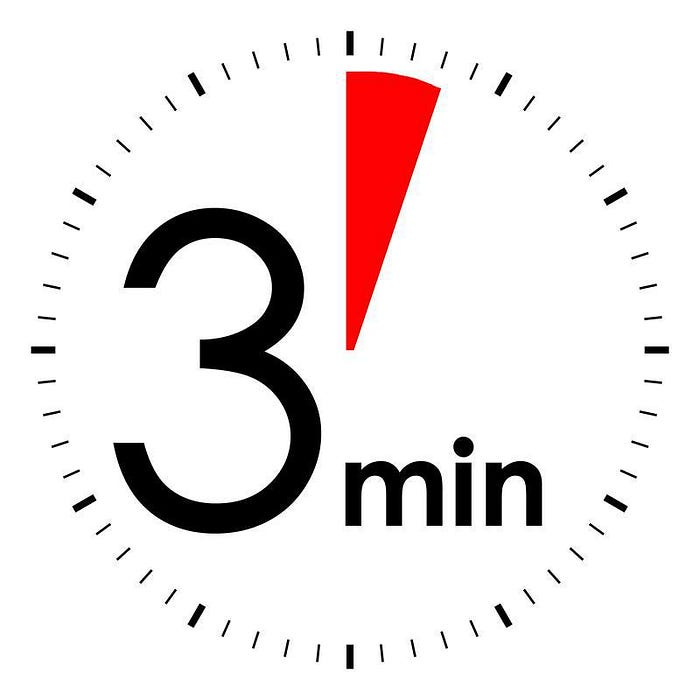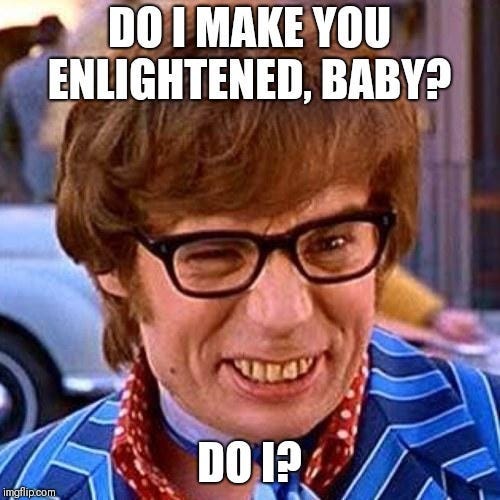Foreword 2024
Some ideas never go out of fashion, they are evergreen, our perspective on them shifting and changing as we grow and learn, and experience. This idea of 3 minute mastery is precious to me. It is a short time-frame that shows me what my “deepest shallow” is. Sure, under perfect conditions I have profound experiences and changes in how I experience the world. But if I only have the time it takes to wait for a kettle to boil - what happens to me?
I originally starting writing this when I used my blogspot account back in 2016. It languished there until 2018, once I switched over to Medium. I’ve made minor tweaks to the phrasing here and there, but this is a glimpses of where I was at over the last eight years when it comes to how I was teaching and what I was practicing. Rounding off with the 2024 version at the end.
2016 iteration
“If you had three minutes to practice, what would you do?”
During our session on Friday [in 2016], while we were loosening up, I asked my student this question. He took about 3 minutes to decide on an answer (I’m so funny). Ultimately he went with some push-up variations with an emphasis on awareness and quality of movement.
He walked me through his decision process:
Initially, he thought to do a “micro-session”; compressing all of a longer session, but he decided against that because it’d be rushed (try being mindful in a rush).
He briefly considered, the rejected, practicing stillness/standing postures, or qigong.
And finally settled on the push-ups because he could benefit from it in that time, come away with something new or building on something.
Listening to him talk, I was grinning like the Cheshire cat (or an idiot depending on how adorable one finds me); his reasoning followed what I had in mind for this educational moment. Firstly, by process of elimination, he choose what he could handle and could leave an impression on him based on: Awareness “critical mass”¹ and time/intensity needed for the experience to become observable and to adjust. Let’s get into what that means to me … .
Awareness critical mass
Most of us don’t walk around constantly being one with the universe and the moment; we need a bit of foreplay to get there,² a process or algorithm, time mainly.
As such, much like the first pancake of a Sunday morning, the initial moments of meditative work is usually an implausible chimera of burned and raw batter awareness and ego, wrinkled and bunched like week-old laundry.³
There’s a latency. We need time for our awareness to gather, to coalesce; allowing thoughts to pass untouched (“what will happen in the next season of Game of Thrones?”⁴, “ do I look cool doing this?”, “did my phone just vibrate?”, “ yeah, I totally look cool doing this”, etc.) Get down to the wordless work.
Time and intensity
In hope of bringing clarity I’ve cleaved awareness, and observation and change in twain. It’s a false paradigm;⁵ what we observe changes our awareness and our awareness affects what we observe; they are like Batman and the Joker … I digress.
My student talked about how much time he needed soaking in the qigong and standing work to notice things. Even though a discomfort will probably be present from early on, it is not intense; below a threshold of observation, noise. This is particularly apparent in poses where the arms are raised in some mystical, and hopefully cool, way. In the beginning, a good quality position⁶ is not obviously necessary. The discomfort in, for example, the shoulders and back are little motes, some would say careless whispers … OK, OK. I, I would say a careless whisper. Eventually, these motes start to grow into a big-ass knives repeatedly stabbing you. As the intensity gathers, it’ll eventually pass a threshold that it gets noticed… “OK, this is definitely not comfortable” / “Owowowow.”
Then one the stimulus (“Owowowow”) becomes large enough we start to adjust and fine-tune to reduce the discomfort.
This approach needs time. Likely, in the first few years of your standing practice, more than 3 minutes. It was certainly the belief I held to for a long time. But more and more, I’m questioning that for myself. (see the 2024 update below).
Master Chee Kim Thong (or so I’ve been told), Jozef and Linda from Fighting Monkey (it’s actually a fundamental premise in their work) Yuri Marmerstein, Emmet Louis, farmers and manual labourers around the world believe you should be ready to do a bear minimum without warning, without preamble. Hell, it’s fundamental requirement for self-defense.
Developing the mentality/body that you need to prepare and work up to take action, can mean there’s a block in place to bringing your taking action at a moment’s notice; such as lifting up someone that has fallen, running away from a dog, tumbling and roughhousing with kids — a habit of warming up, needing time to get ready creates a hesitation, a step back “I’m not sure I can do this…”
Closing thoughts (2016)
Variety being the spice of life, long training sessions are essential for deeping your experience of these types of practices, but the three minute question is a lovely litmus test to see what is more immediately accessible for you, and how that is evolving with time.
Footnotes
Everything sounds cooler when paired with the phrase “critical mass”. Everything… Well… Except for feces, or carbon dioxide in the atmosphere, or bombs… On the upside: critical mass of puppies.
My awesome oneness with the universe is demonstrated by my most recent batch of pancakes (buttermilk, stevia and oats in the mix, yum yum) where the first pancake was pristine; indistinguishable from the others.
This one didn’t age well.
But really, aren’t all paradigms false? Doesn’t the universe keep happening regardless of how we intellectually package the patterns and dynamics around us?
Where the head, chest and hips stacked over feet/base, the arms are driven and supported from the torso not held at the shoulders ball and socket, etc.
Update (2018)
Two years later the “three minute question” remains relevant.
And looking at how I’ve grown since writing the first iteration, as well as my student, how we’d answer the 3 minute question has changed too; now he’s gotten to a point where qigong and postures can affect him within 3 minutes.
It is also lovely to appreciate that even in this time, our way of training has changed. Re-reading the description of the standing postures has reminded me of how differently we train now. We look more holistically, at sensations / structural / connective, e.g:
A sense of elastic loading across the back and hips (cultivating the sensation that my body is a bow, from finger to scalp to toe)
How would I feel if someone pinched me now — indifferent? I should figure out how to be resilient in the position, not hypersensitive.
Or if someone is there, have them push and pull, check and physically understand how the force is absorbed and transmitted to the ground through the meat and bones see some examples here:
2024 supplemental
A lot has happened since 2018, quite a time jump from the perspective of the text. The biggest changes in this period:
The pandemic hit, and I started teaching my standing work online to an open audience.
I most likely had a burn out in 2021, that sapped a lot of vitality from me
I wrote a book about the approach I use, which was an undertaking that went from March 2020 until December 2023 when I finally published it (available in the Amazon of your choice via my landing page :) )
These three things together have allowed me to deeply consider how I share standing and the qigong that I offer.
Booking writing and online teaching
Teaching online has led me to being more direct experience and internal timing driven. When I was teaching mainly in person, I could always fall back on interceding in someone’s training, when my explanations and instructions didn’t have the desired effect. At a distance, that was out the window… And I wanted to be careful about how much verbal instruction I piled on. As such I’ve been tending more and more towards “less is more.” In my online classes, I have seen that people can have very deep insights when I give them a container and some time for their own internal process to be felt and to unfold. The most important thing we did in each session was giving time to settle inside, doing nothing. And routinely, I’ve seen people become deeply relaxed once I gave them permission to do nothing. In terms of mechanical time, they were settling nicely within ten minutes. The online and writing the book also taught me to use recurring questions, or mantras, to help the process continue - my favorite being: “What are you holding up, that you can allow to go downwards; what are you holding down, that you can allow to go upwards?”
(likely) Burnout
The possible burnout has affected my passion to practice for long deep sessions, and a lot of my practice has shifted towards subsistence level practice - managing my energy levels and stress levels through my day. From university in 2002 until prior to 2020, I was diving into 20h of training and practice per week most weeks — hours in the morning and hours in the evening — not feeling a need to do nothing, or feeling mentality or physically exhausted. Having less margin to push myself, and not having as much vitality as I did pre-2020, means working in chunks of 3 - 30 minutes has become important to me as a source of nourishment and restoration.
All that being said…
My baseline awareness and tonus has changed profoundly with each year that has gone by. A relaxation that would have taken me 2+ standing following by another hour or two of qigong practice in 2010, can come to me in 5 - 20 minutes. My default tendency — when I stop doing, stop scrolling, stop talking; when I start sitting, lying, drinking, eating, listening, walking — is to soften, sink, and open. The process I learned through the standing has become mundane to me. It is less me thinking at my body, more allowing what I take to be natural patterns to unfold without my mental intrusion. I experience it as sitting like a dog or a bear, not a monk or a warrior.







